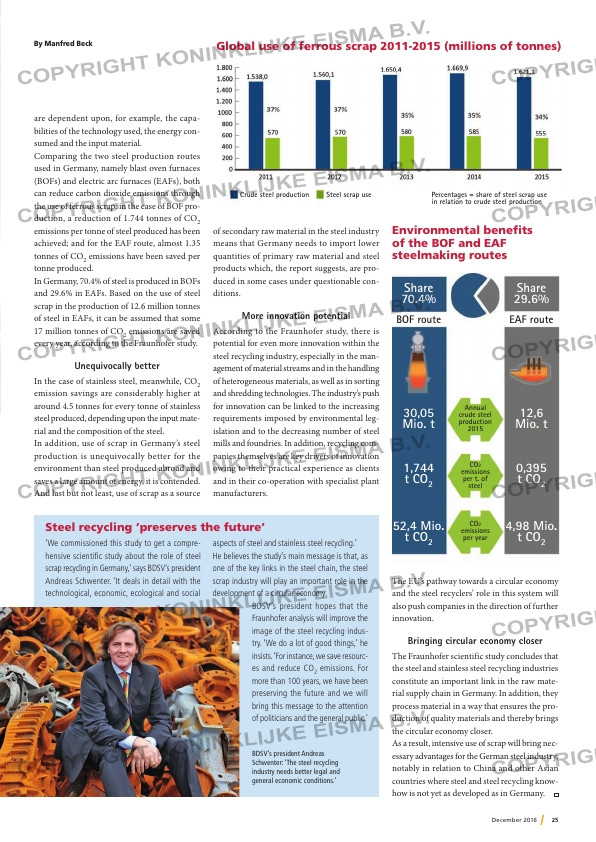Page 25 from: December 2016

25December 2016
are dependent upon, for example, the capa-
bilities of the technology used, the energy con-
sumed and the input material.
Comparing the two steel production routes
used in Germany, namely blast oven furnaces
(BOFs) and electric arc furnaces (EAFs), both
can reduce carbon dioxide emissions through
the use of ferrous scrap: in the case of BOF pro-
duction, a reduction of 1.744 tonnes of CO2
emissions per tonne of steel produced has been
achieved; and for the EAF route, almost 1.35
tonnes of CO2 emissions have been saved per
tonne produced.
In Germany, 70.4% of steel is produced in BOFs
and 29.6% in EAFs. Based on the use of steel
scrap in the production of 12.6 million tonnes
of steel in EAFs, it can be assumed that some
17 million tonnes of CO2 emissions are saved
every year, according to the Fraunhofer study.
Unequivocally better
In the case of stainless steel, meanwhile, CO2
emission savings are considerably higher at
around 4.5 tonnes for every tonne of stainless
steel produced, depending upon the input mate-
rial and the composition of the steel.
In addition, use of scrap in Germany’s steel
production is unequivocally better for the
environment than steel produced abroad and
saves a large amount of energy, it is contended.
And last but not least, use of scrap as a source
of secondary raw material in the steel industry
means that Germany needs to import lower
quantities of primary raw material and steel
products which, the report suggests, are pro-
duced in some cases under questionable con-
ditions.
More innovation potential
According to the Fraunhofer study, there is
potential for even more innovation within the
steel recycling industry, especially in the man-
agement of material streams and in the handling
of heterogeneous materials, as well as in sorting
and shredding technologies. The industry’s push
for innovation can be linked to the increasing
requirements imposed by environmental leg-
islation and to the decreasing number of steel
mills and foundries. In addition, recycling com-
panies themselves are key drivers of innovation
owing to their practical experience as clients
and in their co-operation with specialist plant
manufacturers.
The EU’s pathway towards a circular economy
and the steel recyclers’ role in this system will
also push companies in the direction of further
innovation.
Bringing circular economy closer
The Fraunhofer scientific study concludes that
the steel and stainless steel recycling industries
constitute an important link in the raw mate-
rial supply chain in Germany. In addition, they
process material in a way that ensures the pro-
duction of quality materials and thereby brings
the circular economy closer.
As a result, intensive use of scrap will bring nec-
essary advantages for the German steel industry,
notably in relation to China and other Asian
countries where steel and steel recycling know-
how is not yet as developed as in Germany.
Steel recycling ‘preserves the future’
‘We commissioned this study to get a compre-
hensive scientific study about the role of steel
scrap recycling in Germany,’ says BDSV’s president
Andreas Schwenter. ‘It deals in detail with the
technological, economic, ecological and social
aspects of steel and stainless steel recycling.’
He believes the study’s main message is that, as
one of the key links in the steel chain, the steel
scrap industry will play an important role in the
development of a circular economy.
BDSV’s president hopes that the
Fraunhofer analysis will improve the
image of the steel recycling indus-
try. ‘We do a lot of good things,’ he
insists. ‘For instance, we save resourc-
es and reduce CO2 emissions. For
more than 100 years, we have been
preserving the future and we will
bring this message to the attention
of politicians and the general public.’
By Manfred Beck
BDSV’s president Andreas
Schwenter: ‘The steel recycling
industry needs better legal and
general economic conditions.’
Share
70.4%
30,05
Mio. t
BOF route
Annual
crude steel
production
2015
CO2
emissions
per t. of
steel
CO2
emissions
per year
1,744
t CO2
52,4 Mio.
t CO2
Share
29.6%
12,6
Mio. t
EAF route
0,395
t CO2
4,98 Mio.
t CO2
Environmental benefits
of the BOF and EAF
steelmaking routes
Crude steel production Steel scrap use Percentages = share of steel scrap use
in relation to crude steel production
Global use of ferrous scrap 2011-2015 (millions of tonnes)



